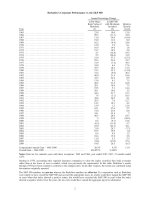Man vs the welfare state
Bạn đang xem bản rút gọn của tài liệu. Xem và tải ngay bản đầy đủ của tài liệu tại đây (9.68 MB, 236 trang )
Man vs. The Welfare State
MAN
VS.
THE
WELFARE
STATE
HENRY HAZLITT
ARLINGTON HOUSE
NEW ROCHELLE, N.Y.
THIRD PRINTING, JUNE I97O
Copyright © 1969 by Arlington House, New Rochelle, New York.
All rights reserved. No portion of this book may be reproduced without
written permission from the publisher, except by a reviewer who may
quote brief passages in connection with a review.
Library of Congress Catalog Card Number 72-93457
SBN 87000-066-7
MANUFACTURED IN THE UNITED STATES OF AMERICA
Preface
THIS BOOK GREW OUT OF A PAMPHLET THAT APPEARED IN
August, 1968, called Life and Death of the Welfare State.
The greater part of the material in it is new, but several
chapters have appeared in advance of this publication in
The Freeman (a monthly published by the Foundation for
Economic Education at Irvington-on-Hudson, New York),
parts of several chapters appeared in my syndicated newspaper column for the Los Angeles Times Syndicate, and
Chapter 16 was published as a pamphlet in Europe in
English, French, and German editions by INFRA (The
International Freedom Academy). I am grateful to the
publishers concerned for permission to republish this material here.
HENRY HAZLITT
Wilton, Conn.
August, ig6g
Contents
PREFACE
V
1.
Instant Utopia
1
2.
Salvation Through Government Spending
4
3.
"We Owe It To Ourselves"
10
4.
Consequences of Dollar Debasement
15
5.
The High Cost of Wage Hikes
23
6.
Price Controls
29
7.
More on Price Controls
34
8.
Who Protects the Consumer?
48
9.
Famines Are Government-Made
54
10.
Runaway Relief and Social Insecurity
57
11.
Income Without Work
62
12.
Fallacies of the Negative Income Tax
84
13.
Can We Guarantee Jobs?
101
14.
Soaking the Rich
104
15.
Soaking the Corporations
109
16.
Government Planning vs. Economic Growth
115
viii
CONTENTS
17.
Government As Prosperity-Maker
137
18.
Uruguay: Welfare State Gone Wild
140
19.
Inflation Is Worldwide
150
20.
The Case for the Gold Standard
153
21.
The Fallacy of Foreign Aid
165
22.
Government Unlimited
180
23.
From Spencer's 1884 to Orwell's IQ84
185
24.
The Task Confronting Libertarians
199
25.
What We Can Do About It
215
INDEX
221
Man vs. The Welfare State
CHAPTER 1
Instant Utopia
IN AMERICA TODAY MOST OF THE OLDER GENERA-
tion—and many of the young—stand appalled at the
nihilism of the self-styled Now Generation and its demands for unattainable reforms, or merely for the sheer
destruction of whatever is established.
But the cynicism, nihilism, and revolt of "youth," and
even of some of its parents, are the result of a common
cause. In the last generation politicians and governments have been promising the voters that they could
not only bring perpetual full employment, prosperity,
and "economic growth," but solve the age-old problem
of poverty overnight. And the end result is not merely
that accomplishment has fallen far short of promises,
but that the attempt to fulfill the promises has brought
2
MAN VS. THE WELFARE STATE
an enormous increase in government spending, an
enormous increase in the burden of taxes, chronic deficits, chronic inflation, and a constant loss in the buying
power of the people's earnings and savings. "Social
Security" has brought an ominous increase in social insecurity.
Another result of the promise of instant utopia has
been a gigantic growth of governmental power—of interference in the details of everybody's business and
everybody's life. As this power has increased, it has also
become concentrated in fewer and fewer hands. In
America the towns and villages have steadily lost power
to the States, the States to the Federal Government, and
Congress to the President.
One mark of the welfare state everywhere has been
the gathering of power into the hands of one man. This
is no mere unfortunate coincidence; it has been inevitable. Thirty-six years ago the eminent Swedish economist Gustav Cassel explained in a prophetic lecture
how "planned economy," long enough continued, must
lead to despotism:
The leadership of the State in economic affairs which advocates of Planned Economy want to establish is, as we have
seen, necessarily connected with a bewildering mass of government interferences of a steadily cumulative nature. The
arbitrariness, the mistakes and the inevitable contradictions
of such policy will, as daily experience shows, only
strengthen the demand for a more rational coordination of
the different measures and, therefore, for unified leadership.
For this reason Planned Economy will always develop into
Dictatorship.
The succeeding chapters of this book explain in detail the ideology and methods behind the present inflation and aggrandizement of State power, the conditions
Instant Utopia
3
to which it has led and, finally, the solutions we must
apply if this sinister threat—not only to the economic
future of the American people but to the future of civilization itself—is to be averted.
CHAPTER 2
Salvation Through
Government Spending
IN THE EARLY NINETEEN THIRTIES, IN THE DEPTH OF
the Great Depression, the theory became fashionable
that the cause of all depressions was Lack of Purchasing
Power. The people just did not have enough money,
and because of unwarranted pessimism they were
refusing to spend enough even of what they had. The
solution was therefore simple: at such a time the government should boldly increase its own spending,
"prime the pump," and "get things moving again."
Naive advocates of this theory assumed that more
government spending was the whole answer. The more
sophisticated advocates saw that the increased spending would not give people more purchasing power if
the government kept the budget balanced and took it
Salvation Through Government Spending
5
all away again in higher taxes. The thing to do was to
spend more without taxing more. The trick, in other
words, was deliberately to unbalance the budget—to
run a deficit.
Most of the champions of deficits—including the
eminent John Maynard Keynes himself, the theory's
chief architect—at least publicly professed to believe
that the required deficit could be financed by selling
bonds directly to the public, to be paid for out of savings. But again, the more sophisticated deficiteers must
have seen that a man who buys a $1,000 bond out of his
savings surrenders that much purchasing power for the
life of the bond. In short, he loses just as much buying
power as the government gains. On net balance, no new
buying power has been created.
How, then, can the government "create" new purchasing power? It can do so only if it does not increase
taxes at all, but "sells" its bonds to the banking system,
and if the banks "pay" for them by creating deposit
credits on their books in favor of the government. This
leads to an increase in "the money supply"—that is, an
increase either in the amount of currency or of demand
bank deposits.
If the government's new bonds are sold directly to
member banks, there tends to be a dollar-for-dollar increase in the money supply compared with the amount
of new bonds. But if the government's securities get
into the hands of the Federal Reserve Banks, they are
used to create what is called "high-powered" money.
This can lead to the creation of about $6 of new money
for every dollar of new government securities.
It is not easy to give a satisfactory but short explanation of the reason for this to readers without any previous knowledge of monetary theory. When member
banks "buy" government bonds and "pay" for them by
creating a deposit credit on their books against which
6
MAN VS. THE WELFARE STATE
the government can draw, they are adding to the nation's supply of purchasing media. They are creating
money out of government promises, and some would
say they are creating money out of thin air.
Now if a member bank that has bought such government bonds sells them to its regional Federal Reserve
Bank, it can ask that Reserve bank to credit the proceeds to the member bank's reserves with that Reserve
bank. But if the member bank is a "city bank," it is
required to keep a reserve with the Federal Reserve
Bank of only l6½ per cent against its net demand
deposits. This means that the member bank is entitled
to lend, and so create demand deposits for, about six
times the amount of its reserves with the Federal Reserve Bank. That is why money created directly or indirectly by the Federal Reserve Banks is called
"high-powered" money.
Thus new "purchasing power" is brought into being.
Thus people have more money to buy more goods, create more jobs, stimulate more output, and restore prosperity.
At least so it seems for the moment. But soon there are
other consequences.
If there have been heavy unemployment and much
"idle capacity," the new monetary purchasing power in
the system, by increasing the demand for commodities,
may indeed lead to an increase in production, and
hence to an increase in employment. This has been
hailed as the great Keynesian contribution to economic
theory and policy. But there are fatal flaws in it.
Unless there were some serious lack of coordination
among prices, costs, and wages, mass unemployment
would not exist in thefirstplace. When it does exist, the
only appropriate cure is individual adjustment of
prices, costs, and wages to each other—the return of
coordination. But this can be brought about automati-
Salvation Through Government Spending
7
cally only if the competitive forces of the market are
given free play.
The reason the Keynesian medicine can work—under special conditions and for short periods—is that by
increasing monetary demand and prices it may increase both sales and profit margins, and so restore production and employment. Yet this could be done even
more effectively—and without the poisonous sideeffects and after-effects—by restoring freedom of competition and individual coordination of prices and
wages.
The Keynesians think in terms of aggregates. Their
remedy is to increase the total money supply, and
thereby to bring the price "level" sufficiently above the
wage "level" to restore or maintain profit margins and
so keep the wheels of industry spinning at full speed.
This remedy is defective in two respects. It tacitly
assumes that there is a uniform discrepancy between
prices and wages and a uniform percentage of "idle
capacity" throughout industry. Neither is true. If "industry" is estimated to be operating at 80 per cent of
capacity, we must remember that this figure is at best
an average. It may cover a situation in which, say, industry A is operating at only 60 per cent, industry B at 63
per cent, and so on up to industry M at 97 per cent and
industry N at 100 per cent. If we try to expand the
money supply enough to return industries A and B to
full capacity, we may completely "overheat" industries
M and N and produce serious productive distortions
and bottlenecks.
What is more, an increase in the stock of money,
contrary to Keynesian theory, will begin to force an
irregular increase in prices long before "full capacity"
has been reached and the "slack" taken up—if only for
the reason that the "slack" is never unifrom throughout
industry. In a very short time, also, with the increase in
8
MAN VS. THE WELFARE STATE
prices and the increase in the demand for labor, wages
will start climbing too. Then, if the previous trouble was
that most wages were already too high in relation to
most prices, there will again be discoordination between wages and prices; and the Keynesian prescription will call for still further doses of government
spending, deficits, and new money.
So the Keynesian medicine must lead to chronic deficits and chronic inflating of the money supply. This is
precisely what we have had. It is no accident that we
have just run eight annual deficits in succession, and
that we have had 32 deficits in the last 38 years. It is no
accident that the U. S. money supply (currency plus
demand deposits) has been increased more than fivefold—from $36 billion at the end of 1939 to $199 billion
in September, 1969. And so it is no accident that, in
spite of a tremendous increase in industrial production
in this thirty-year period, consumer prices have increased (to June, 1969) by 164 per cent.
Today the Federal Government is spending in a single year 26g times as much as in the fiscal year before
the outbreak of World War I. The recent increase in
annual spending is being attributed by government
spokesmen to the cost of the war in Vietnam. Yet
though in 1970 scheduled national defense expenditures are $35.6 billion greater than in i960, total expenditures are $103.1 billion greater. This means that
non-defense expenditures alone have increased $67.5
billion in the same period. It is not the war, but the
determination to impose the welfare state, that has led
to this incredible squandering.
A central fallacy of Keynesianism, as of all inflationary nostrums, is that they chronically confuse "income"
in terms of paper money with real income in goods and
services. It is possible to increase paper-money income
to any amount by debasing the currency. But real in-
Salvation Through Government Spending
9
come can only be increased by working harder or more
efficiently, saving more, investing more, and producing
more.
So let us not be too impressed by politicians who
constantly cite the increase in dollar incomes, in dollar
"gross national product," to show that we never had it
so good. In Italy today, as a result of past inflations, it
takes 624 lire to buy an American dollar. So anyone in
Italy with an annual income or even total property
worth more than $1,600 American dollars is already a
millionaire in his own currency.
CHAPTER 3
"We Owe It To Ourselves"
AT THE OUTBREAK OF WORLD WAR I, THE NATIONAL
debt amounted to only $1.2 billion. At the end of 1919
it had swelled because of that war to $25.5 billion. But
there was a national sense of responsibility about it.
Prudent policies were followed. Successive Republican
administrations reduced it at a rate of nearly $1 billion
a year, so that at the end of 1930 it was down to $16.2
billion.
But then, well before we got into World War II, welfare spending started to soar. There was no effort to
balance the budget; the cult of deficits prevailed. At the
end offiscalyear 1941,fivemonths before Pearl Harbor,
the public debt was at the then record level of $55.5
billion. We ended the war with a public debt of $260
"We Owe It To Ourselves"
11
billion, but this time there was no important reduction,
except almost by accident in 1948 and 1951. Chronic
deficits have now brought it up to $363 billion.
It is amusing to recall the rationalizations that accompanied each succeeding deficit. At first each presidential message would solemnly estimate a surplus for the
next fiscal year, which always turned out to be a deficit
before the year was over. Next, the budget was always
to be balanced sometime in the next couple of years—
but, of course, not now.
Then a new doctrine began to be put forward. It set
up a straw-man: the conservative who allegedly insisted
that the budget must be balanced every year, come hell
or high water. Ah no, this new doctrine replied; the
budget need be balanced only over a period. But the
high priests of the new doctrine never got around to
specifying just how long the period should be, or just
when it would be safe to begin to show a surplus again.
They showed no ardor for sticking to the arithmetic
even of their own proposals. If, as in the eight years 1961
through 1968, there was an uninterrupted average administrative deficit of $8 billion a year, shouldn't there
be an average surplus of $8 billion a year for the next
eight years?
The argument for a budget balanced "over a period"
has, in fact, been quietly dropped. In its place is the
argument that the budget should never be balanced
when there is less than full employment, or even when
there threatens to be less than full employment. And
this again has become in fact an argument for a perpetual deficit. For though President Johnson's economic advisers called for and got a tax increase (but
never called for a spending cut), no one dreamed of
suggesting a surplus, or even a balanced budget. In
presenting his budget for the fiscal year 1968, for example, President Johnson planned a deficit of $4.3 billion
12
MAN VS. THE WELFARE STATE
in the cash budget and of $8.1 billion in the orthodox
administrative budget. (The actual administrative deficit turned out to be $25.4 billion.) "To seek a lower
deficit or a surplus" for 1968, he warned, "would be
unwarranted and self-defeating" because it would "depress economic activity."
The implication of this whole philosophy is that it is
dangerous even to balance the budget, and that so far
from trying to pay off or even reduce the national debt,
we should permit a perpetual increase.
Let us look at what this has already meant for annual
interest payments alone. They have doubled in the last
ten years—from $8.3 billion in i960 to $16 billion in
1970. Thus interest payments alone are every year
greater than the entire amount it took to run the government in 1941, and more than five times as much as
was required to run the government in 1929.
In 1932 Candidate Franklin Roosevelt was alarmed
because the national debt had increased by $3 billion
in the preceding two years. But for a generation the size
and growth of the national debt have been lightly dismissed with the argument that "we owe it to ourselves."
This was presented in the Nineteen Thirties as a brilliant discovery of the "new" economics; but the argument is so old that it was familiar to the great British
philosopher David Hume, who answered it in a brilliant
essay in 1740: "The practice of contracting debt will
almost infallibly be abused in every government . . ,
We have indeed been told that the public is no weaker
upon account of its debts, since they are mostly due
among ourselves." But Hume then went on to point out
that the creditors who received the interest on the debt
were by no means the same people as the taxpayers
who had to pay it, and that practically no one paid and
received exactly the same amount. The tax burden fell
mainly upon the active workers and producers, and
"We Owe It To Ourselves"
13
hampered production. "If all our present taxes be mortgaged," he asked, "must we not invent new ones? And
may not this matter be carried to a length that is ruinous
and destructive?"
"I must confess," he also wrote in the course of his
essay, "that there is a strange supineness, from long
custom, creeped into all ranks of men, with regard to
public debts," so that hardly anyone dared to hope that
substantial progress would ever be made in paying
them off. We find plenty of evidence of this complacency today. Academic economists even vie with each
other in trying to prove that the situation is after all very
good.
A favorite argument of the last few years is that "the
nation is growing faster than its debt." This is "proved"
statistically. In the table below, for example, I merely
bring up to mid-1969 some comparisons presented (in
billions of dollars) by one academician in 1964:
i945
W69
National debt
$260
$359
Gross National Product
$212
$925
Debt as burden on GNP
123%
39%
So we might advance triumphantly to the conclusion
that the national debt, when viewed as a burden on a
year's production, has been cut by two-thirds since
1945!
T h e conclusion would be technically correct, but
complacency would be unjustified. The reason the national debt is less of a burden is that, through inflation,
the purchasing power of the dollar has b e e n steadily
14
MAN VS. THE WELFARE STATE
reduced. It has been reduced 65 per cent since 1933
and more than 50 per cent since 1945. Let us state this
another way. By failing to balance its budget, by borrowing, by monetizing the debt, by printing more dollars, by steadily diluting the dollar's purchasing power,
the government has in effect repudiated 65 cents of
every dollar it borrowed in 1933 and 50 cents of every
dollar it borrowed in 1945.
To put it bluntly, the government's creditors have
been swindled.
Adam Smith, writing in 1776, was perfectly familiar
with this method of disguised repudiation. "When national debts have once been accumulated to a certain
degree," he wrote, "there is scarce, I believe, a single
instance of their having been fairly and completely
paid." But governments usually covered "the disgrace
of a real bankruptcy" by the "juggling trick" of "a pretended payment" in depreciated money.
So the relationship that seems to give some presentday writers so much satisfaction—that the national
debt, in dollar terms, has been falling in relation to the
gross national product in dollar terms—is simply the
outcome of the steady depreciation of the dollar. The
more inflation we have, and the more the purchasing
power of the dollar is depreciated, the more the national debt will "fall" in relation to the GNP, because
the GNP, measured in soaring prices, will rise in relation to the dollar debt.
Do we have any serious intention of ever paying off
our national debt in dollars of at least present purchasing power? If so, isn't it about time we begin to balance
the budget and make an honest start?
CHAPTER 4
Consequences of Dollar
Debasement
L E T US BEGIN BY RECALLING TWO COMPARISONS
already mentioned. From the end of 1939 to the end of
1968 the United States' stock of money (hand-to-hand
currency plus demand bank deposits) has been increased more than fivefold—from $36 billion to $193
billion. In the same thirty-year period (in spite of a huge
increase in industrial production), prices of goods and
services increased by an average of 164^,per cent.
This debasement of the dollar resulted in a succession
of problems, including a chronic "deficit" in the American balance of payments.
The "balance-of-payments problem" has arisen not
merely because of our domestic inflation but because of
the combination of this with the so-called "gold ex-









